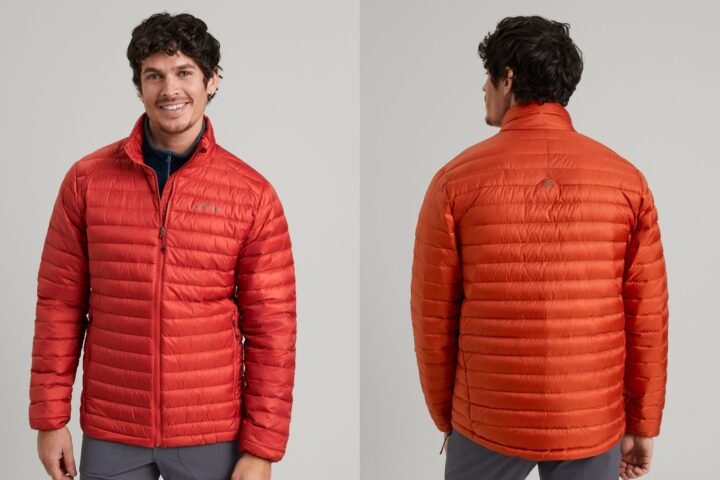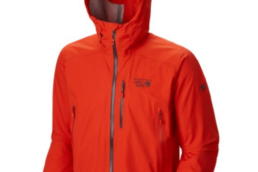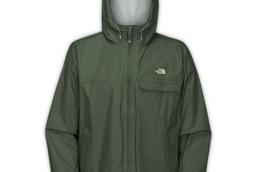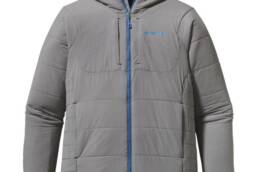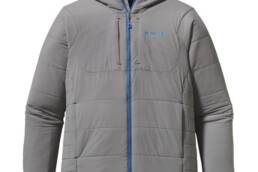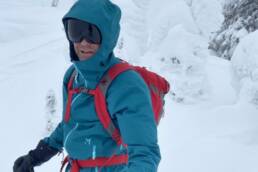New Zealand clothing company Kathmandu has arrived in Canada. Our editor Vince Hempsall reviews its offerings, including the Heli R down jacket, to see if they stand up to a good ol’ Northern Hemisphere thrashing.
Apparel company Kathmandu was established in New Zealand in 1987 with the launch of its original fleece jacket. Thirty-six years later its offerings have expanded to include all manner of clothes for men and women as well as backpacks and bags. It’s territory has also expanded and in 2023 Kathmandu moved into the Canadian market and is now available at MEC, Altitude Sports and online at kathmanduoutdoor.ca.
Through all of its expansion, the company has maintained a sense of environmental integrity (it created one of the world’s first recycled fleece jackets in 1991) and social responsibility. It’s the first equipment retailer in NZ and Australia to become a certified B Corp, which means it’s part of an initiative run by the non-profit global organization B Lab that seeks to improve the way profits and growth impact employees, economies, communities, and the environment.
Snapshot: Kathmandu Heli R Down Jacket
-
- Pros: Each garment has a QR code that, when scanned, tells the story of its design and manufacturing process and materials used. Oh yeah, and it’s one of the few puffy jackets you’ll find for less than $200.
- Cons: The core of the Heli R down jacket is a bit voluminous, which is fine when skiing but not ideal for alpine climbing.
- Price: $199.95 Cdn
- Who Should Buy: Adventurers and cold-climate denizens who care where and how their garments are made.
- Who Shouldn’t Buy: Hipsters looking for a more form-fitting garment.
- Helpful Hack: The right-hand pocket doubles as a stuff sack for the jacket.
- Author’s overall rating: 8/10
The Test
Since receiving the Kathmandu Heli R down jacket in August, I’ve worn it on the top of some of the most iconic climbs in Bugaboos Provincial Park, including Snowpatch and Bugaboo Spires, and it’s been to the summit of Udo Peak in Rogers Pass. I’ve also worn it on casual outings around the mountain town where I live and while belying at the crag during cool autumn mornings.
The Verdict
I was first introduced to the Kathmandu brand during a year-long tour of New Zealand at the turn of the century. I was impressed by the product’s style, comfort, commitment to the environment, and the fact that with a favourable Canadian exchange rate, it was totally affordable for a dirtbag climber like me. In fact, I was so impressed, I’d ask my Kiwi mates living in Canada to bring me back items whenever they returned home for a visit. So I was stoked to learn Kathmandu had made the jump across the pond this year and was now available in this country. I received a Heli R down jacket to review along with two items of lifestyle clothing: the Carrillon shirt, and a pair of light hiker pants.
The first thing I noticed with the Kathmandu Heli R down jacket was its ultra-soft fabric: the exterior shell and interior lining are made with 100% recycled polyester but it practically feels like cashmere. And it’s super light, weighing in at only 300 grams, thanks in large part to the 600 fill duck down, which is traceable and responsibly sourced as per the company’s RDS certification. The second thing I noticed was the jacket’s roominess. I’m 5.11 (180cm) and 170 pounds (77 kg) with a climber’s build and I received a size medium. The sleeve and waist lengths were great but, even with multiple under-layers, there was a lot of empty volume left in the torso. That will be fine for the coming ski season but I found the jacket a bit too voluminous for alpine cragging as it kept ballooning above my harness. If you’re more barrel-chested, this jacket is for you.
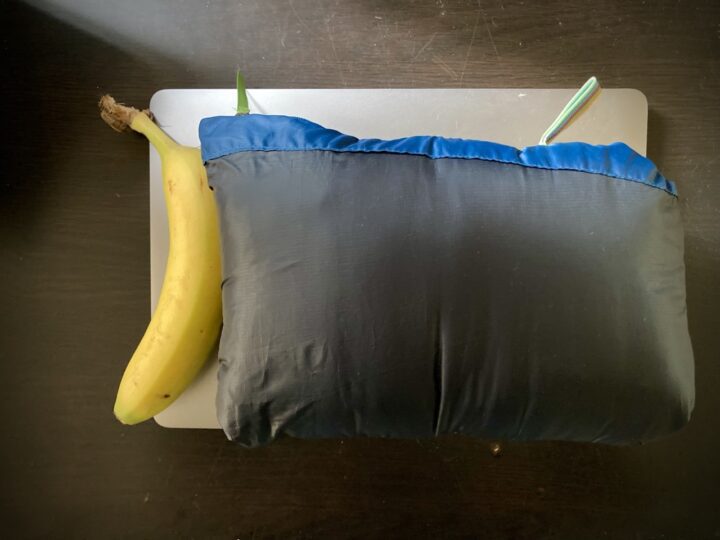
Other physical features I like about the Heli R down jacket are the elastic cuffs and drawstring waist, the two inner and two outer hand pockets, and the cut of the shoulders with its main seam that curves down the front towards the armpit, which allows for better range of motion when climbing. And of course I like the price because it’s hard to find a puffy jacket under $200 these days. One physical attribute I wasn’t so keen on was the stuff pocket. The front pocket doubles as a stuff sack and it’s so deep that the compressed jacket still measures 11″ (30cm) across. But that’s a super-minor complaint because the jacket will compress even further when shoved into a backpack.
That all said, the attributes I find most notable about the Heli R down jacket are its environmental and social merits. As mentioned above the materials of the jacket are fully recycled and ethically sourced.
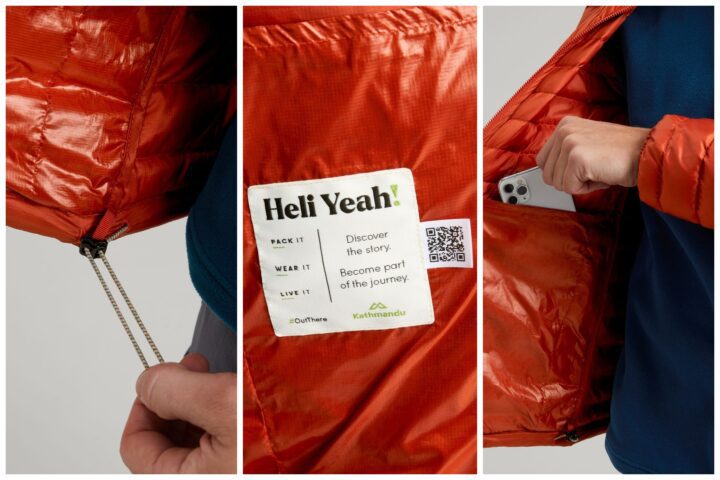
But Kathmandu goes one step further and includes a QR code on every jacket that, when scanned, takes you to a landing page that explains where that specific garment came from, how it was designed and created, and tips to prolonging its life. This accountability is absolute genius and I wish every company was forced to do it, from my local coffee slingers to tech giants. It would significantly change consumer habits if we knew whether our purchases were responsibly made or produced by slaves.
In summation, I’m extremely happy Kathmandu is now available in Canada and although the Heli R down jacket is a bit too voluminous in the torso for all my outdoor pursuits, I’ll be supporting the brand with further purchases because of their environmental and social stewardship.
Kathmandu Heli R Down Jacket – The Deets
-
- MSRP: $199.95 Cdn
- Weight: 300 grams
- Sizes: XS-XXL
- Colours: Red Earth, Undertow, Black Stingray, Undertow, Beech/Dark Moss
- Made of 100% recycled polyester with 600 fill duck down that’s ethically sourced
- 2 zippered hand pockets
- 2 internal drop pockets
- Elastic binding on cuffs and drawstring hem
- For more info: kathmanduoutdoor.ca
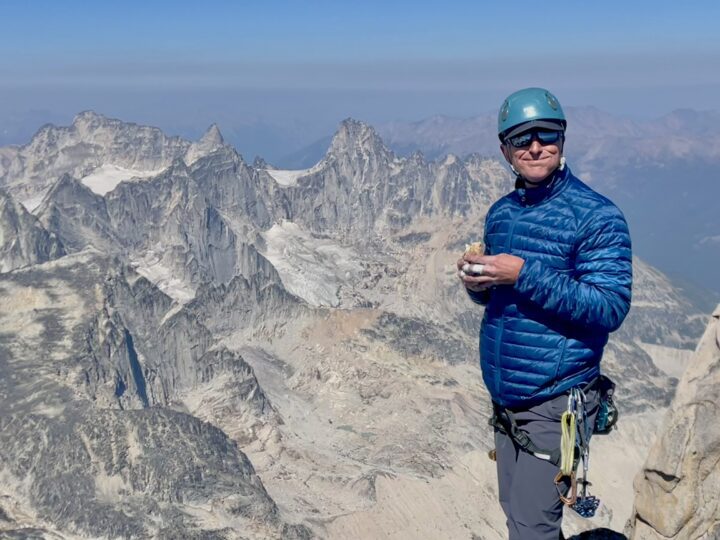
Bonus Review – The Kathmandu Carrillon Shirt
Along with the Kathmandu Heli R down jacket, I received the Carrillon long-sleeve shirt and a pair of light-hiker pants. The latter were extremely comfortable and allowed for excellent range of movement because of the materials: 85% nylon and 15% Elastane. However, they’re not designed for alpine climbing and I trashed the knees while whimpering my way up the classic Roof Mctech climb in the Bugaboos. You can still see them in good shape in the photo above, taken on the summit of Bugaboo Spire, and I’m sure they’d make a great hiking pant; I just don’t do a lot of that.
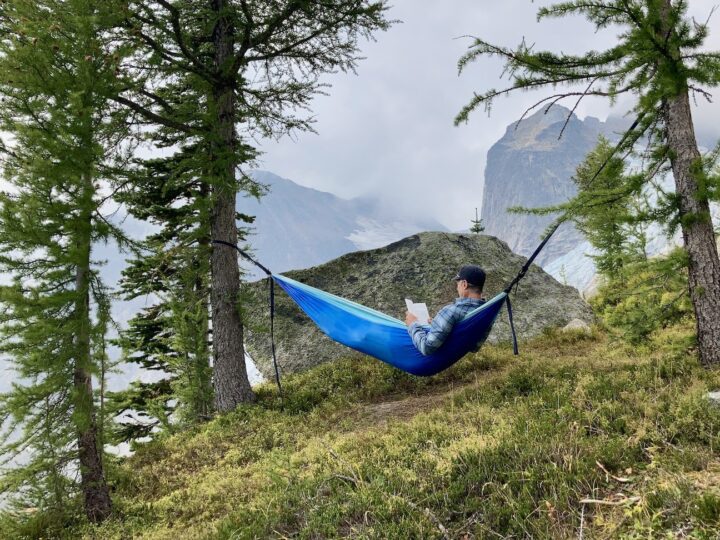
I really enjoyed the Kathmandu Carrillon shirt, however, because it’s the perfect rest day attire. In fact, I’m wearing it while writing this review because not only is it a great piece of apparel for hanging out in the hammock or at the alpine hut, it’s also excellent for the office. I’m amazed at the soft feel of this 100% cotton button-up shirt and I’m also impressed by Kathmandu’s commitment to Better Cotton, a non-profit governance group that promotes better standards in cotton farming across 21 countries.
The other cool thing about the Carrillon shirt is it’s crafted using hollow fibre yarn so while the shirt looks robust and is warm enough to wear on its own while hanging out in the alpine on an overcast rest day, it’s extremely light. In fact, the medium size I received weighs in at a scant 320 grams. That’s almost the weight of some of the other flannel shirts I have in my closet. The Kathmandu Carrillion shift is now one of my favourite go-to garments for weekly endeavours to the crag, the pub, and the office.

Kathmandu Carrillon Shirt – The Deets
-
- MSRP: $109.95 Cdn
- Weight: 320 grams
- Sizes: S-XL
- Colours: Ripple/Meteor Check; Natural/Sunlit Check; Dark Quartz/Deep Lagoon Check
- 100% cotton
- 2 buttoned chest pockets
- For more info: kathmanduoutdoor.ca
Author’s Note: Mountain Culture Group is not paid for these reviews. They are honest expressions of our opinions. In some instances we are given the product to keep but that does not sway our assessment. If we dislike a product and feel it would score a rating of less than 5/10, we simply won’t review it.
Vince Hempsall
Vince Hempsall lives in the beautiful mountain town of Nelson, British Columbia, where he spends his time rock climbing, backcountry skiing and mountain biking (when not working). He is the editor of Kootenay Mountain Culture Magazine and online editor for the Mountain Culture Group.
Related Stories
Review: Patagonia Nano-Air Jacket
You may notice we don't review a ton of gear on here, but when we stumble across certain products we feel we…
Review: Mountain Hardwear Men’s Stretch Ozonic Jacket
Leaves are turning and pumpkins are out everywhere. It’s that time of year when the rowdiest of adventures return to…
GEAR REVIEW: Patagonia Nano-Air Jacket
You may notice we don't review a ton of gear on here, but when we stumble across certain products we feel we…
Honest Review: MADE Custom Apparel Hard Shell Jacket
Publisher Peter Moynes logs on to get a custom jacket designed by MADE apparel. Is this the future of outdoor clothing?…



